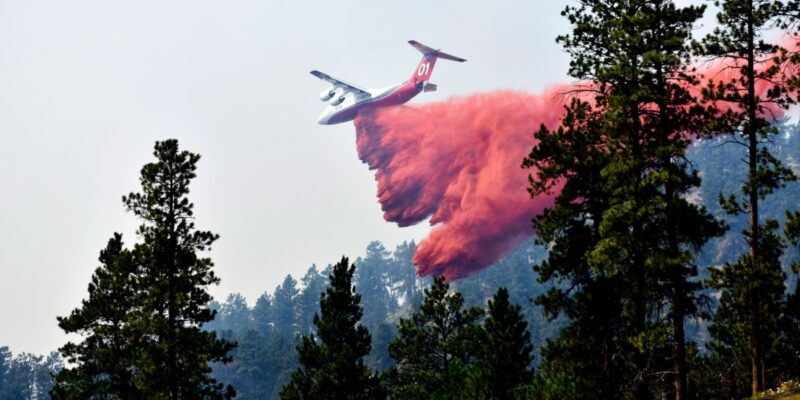
This story was originally published by High Country News and is reproduced here as part of the Climate Desk collaboration.
On a hot, dry August day in 2002, air tankers swooped over a small wildfire south of Bend, Oregon. The Forest Service hoped to suppress the flames by dropping over a thousand pounds of fire retardant on and around the fire—but the pilots missed. Instead, the neon-red liquid cascaded into the nearby Fall River, a tributary of the Deschutes. Soon after, at least 22,000 trout died—virtually all the fish living in a six-mile stretch.
Retardant contains ammonium phosphate, which is highly toxic to fish and other aquatic life. In the years following the accident, foresForest Service Employees for Environmental Ethics (FSEEE), a Eugene, Oregon-based nonprofit that represents former and current Forest Service employees, has called for policy changes regarding the use of retardant. The group has won two lawsuits against the Forest Service restricting its use and is now suing the agency over employing it in and around streams and creeks. The suit has reignited debates over retardant’s firefighting efficacy, and the outcome could change how it is used in the future.
In a suit filed in Montana’s Federal District Court last October, FSEEE argued that fire retardant is a pollutant, so the Forest Service needs a Clean Water Act permit if it flows into waterways. The agency is now working with the Environmental Protection Agency to get the appropriate federal and state permits, but that process will take at least two years.
In the meantime, FSEEE has asked the judge to issue an injunction barring retardant within 600 feet of water, doubling the distance required by current Forest Service policies. In a legal document filed in February, the agency said that request could prevent pilots from using retardant at all. “The only way to prevent accidental discharges of retardants to waters is to prohibit its use entirely,” Jerome Perez, the national director of fire and aviation management, stated. A decision is expected before fire season starts in earnest this summer.
The Forest Service considers retardant a critical wildfire-suppression tool. The substance is made up of roughly 85 percent water—which helps it disperse uniformly—and 10 percent ammonium phosphate, a salt found in fertilizer. It also contains small amounts of thickeners, which help it stick to trees and bushes, as well as coloring that helps pilots see where they’re dropping it. When the heat of a wildfire meets vegetation coated in retardant, the ammonium phosphate encourages organic material to release water, creating moisture that slows down combustion.
But when retardant is dropped in waterways, it suffocates fish. In 2009, scientists found roughly 50 dead fish and elevated ammonium and phosphate concentrations in a California stream following nearby retardant use. After a 2011 environmental impact statement, the Forest Service required pilots to avoid applying retardant within a 300-foot buffer zone around waterways and to skirt certain habitats and populations altogether.
Even so, between 2012 and 2019, the agency dropped 761,282 gallons into water, 95,708 gallons into buffer zones and 248,285 gallons into the habitats of endangered and threatened species. The majority of incidents were accidental, but some were sanctioned exceptions; Forest Service policies consider it acceptable to drop retardant into waterways when life or property is threatened or damage to natural resources outweighs loss of aquatic life, though such applications represent just 0.3 percent of the 279 million gallons used in those years.
Despite retardant’s wide use, FSEEE Executive Director Andy Stahl questions its efficacy. “I call it faith-based firefighting, because there’s actually no empirical evidence that retardant makes any difference in wildfire outcomes,” he said. “Everybody knows that it’s done because it looks good on CNN, and because communities who feel threatened by fire want to know where the air tankers are.” FSEEE’s own analysis of Forest Service data did not find a correlation between retardant use and wildfire’s size or spread. “Why would we be permitting pollution that doesn’t accomplish anything?” Stahl said.
Retardant efficacy is difficult to measure: In the field, it’s combined with other tactics, such as dropping water and building fuel breaks. When a fire is successfully contained or extinguished, it’s hard to credit retardant as the sole reason. And it certainly has its limits; it can only be dropped during the day, when there’s enough light to fly safely, and it’s hard, if not impossible, to apply in high winds. Dense tree canopy can also keep retardant from reaching the forest floor.
Still, Chris Jurasek, an assistant chief of tactical air operations with Cal Fire, said he and other firefighters have seen retardant’s efficacy firsthand. “I know fire retardant works, because for 12 years…I watched it more times than not to be effective in either slowing, controlling or having an advantageous outcome on the incident,” he said. (The Forest Service declined to comment on how the agency measures retardant’s effectiveness, or to answer questions about how firefighting would change if it wasn’t an option.)
In response to FSEEE’s lawsuit, U.S. representatives introduced a bill in March that would exempt fire retardant from the Clean Water Act, saying that firefighting efforts would be hampered without it. “We’re putting a lot of people, a lot of land, a lot of wildlife in peril,” said co-sponsor Rep. Doug LaMalfa, R-Calif.
If passed, the bill would be a rare exemption to the groundbreaking legislation adopted in 1972. Mark Ryan, a retired EPA attorney who specialized in the Clean Water Act, notes that permitting retardant would be tricky. “How do you write a permit for something that’s being applied at 250 miles per hour in an emergency situation, with very little if any time to assess what’s really happening on the ground?” he said. “That’s a nightmare permit to write.”
In a congressional hearing on the bill, Forest Service leadership painted retardant use as a matter of life and death. “If we lose the ability to use retardant, it would be a critical loss of an essential tool to protect communities,” said Deputy Chief Chris French. “It’d be crippling.” Paradise, California, which was eviscerated by a wildfire in 2018, has also defended the use of retardant. “When you start putting fish above people’s lives and their homes, I’m sorry, that is just not acceptable,” Mayor Greg Bolin told a local TV station.
Even if the Forest Service scales back its use, issues remain. For one, other agencies will likely continue to use it: Cal Fire currently dispatches two air tankers with retardant to every wildfire. Other firefighting tools, like foams and gels, also contain chemicals. And other wildfire-caused hazards also kill fish: Tens of thousands died in the Klamath River last year after mud and ash from landslides choked the river. For now, French said, the Forest Service will continue to use retardant—until it’s ordered not to.















